Study of Semi-Adiabatic Temperature Rise Test of Mineral Admixture Concrete
Abstract
:1. Introduction
2. Semi-Adiabatic Temperature Rise Test and Finite Element Analysis Method of Concrete
2.1. Semi-Adiabatic Temperature Rise Test of Concrete
2.2. Finite Element Analysis Method for Hydration Heat Release of Concrete
2.3. Finite Element Analysis Model of Semi-Adiabatic Temperature Rise Test Device
3. Optimal Design of Semi-Adiabatic Temperature Rise Test Device
3.1. Influence of Insulation Layer Thickness on Semi-Adiabatic Temperature Rise Test
3.2. Influence of Thermodynamic Parameters of Thermal Insulation Materials on Semi-Adiabatic Temperature Rise Test
3.3. Influence of the External Environment of the Insulation Layer on the Semi-Adiabatic Temperature Rise Test
4. Semi-Adiabatic Temperature Rise Test Scheme and Data Analysis
4.1. Semi-Adiabatic Temperature Rise Test Scheme
4.1.1. Test Device
4.1.2. Mix Ratio of Concrete Test Block
4.1.3. Test Process
4.2. Analysis of Test Data
4.2.1. Temperature Change Data Analysis
4.2.2. Temperature Fitting Curve Analysis
5. Conclusions
- (1)
- The optimal design of the semi-adiabatic temperature rise test was as follows. The test object was set as a concrete cube block with a side length of 20 cm, a cube incubator was used to completely wrap the internal concrete test block, the optimal thickness of insulation material is 10 cm, the insulation material is a polyurethane insulation material with good thermal insulation ability (low thermal conductivity), the change in external heat dissipation conditions has less influence on temperate rise so the surface of the incubator was not treated, and the test was carried out on a conventional concrete test ground.
- (2)
- For mineral admixture concrete, the reduction in hydration heat is independent on the type of mineral admixture added. The decrease in hydration heat is related to the content of different mineral admixtures and material properties. An optimized semi-adiabatic temperature rise test was conducted, and the temperature rise performance of four common mineral admixtures was compared as follows: (1) total cooling capacity: limestone powder > slag, fly ash > metakaolin; (2) early heat generation rate: metakaolin > slag > fly ash > limestone powder; (3) heat reduction rate in the middle and late periods: metakaolin > limestone powder > fly ash > slag. Instead of the same content of cement, the concrete mixed with fly ash and limestone powder exhibited the best cooling performance, and it is recommended for use in engineering.
- (1)
- Many experiments are needed to fit the data of the semi-adiabatic temperature rise curve to provide reliable theoretical support for the project.
- (2)
- Try to make a simple semi-adiabatic temperature rise test model that can simulate the on-site structure to avoid the influence of size on the test.
- (3)
- The finite element simulation part of this paper is to provide reasonable parameter settings for the experimental part, since the content of the simulation part is not consistent with the experimental part. This is an inadequacy of this article. Therefore, the experimental content can be simulated for further validation.
Author Contributions
Funding
Data Availability Statement
Conflicts of Interest
References
- Action Plan for Green Urban rail Development of Urban rail Transit in China. China Metros 2022, 8, 20–35.
- Yuan, G.L.; Huang, F.Y.; Shen, H.; Gao, P.F. Research on temperature field and thermal stress of hydration heat in massive concrete of construction period. Concrete 2005, 2, 86–88. [Google Scholar]
- Qin, W.Z. Shrinkage and cracking of concrete and its evaluation and prevention. Concrete 2001, 7, 3–7. [Google Scholar]
- Lin, Z.H.; Qin, W.Z.; Zhang, S.H.; Zhang, T. Development of stress and evaluation of cracking sensitivity of concrete at early ages. Archite Technol. 2003, 1, 34–35. [Google Scholar]
- Zhou, Z.P. Water leakage control in the main structure of a metro station. Mod. Tunn. Technol. 2012, 49, 164–170. [Google Scholar]
- Duan, Z.; Ma, C.L.; Wang, L.L. Causes and prevention of cracks in cast-in-place mass concrete. Concrete 2003, 5, 48–58. [Google Scholar]
- Zhu, Y.T.; Zhan, S.L. Study on reasons and prevention measures of cracking in concrete tructure. J. Mater. Sci. Eng. 2003, 5, 727–730. [Google Scholar]
- Jiang, X.P.; Wang, S.L.; Duan, S.X.; Sun, Y. Mechanism analysis of temperature crack appear of super mass concrete and new methods of anti-rack. Concrete 2007, 12, 98–102. [Google Scholar]
- Chen, Y.; Zhang, Q.S. Review of study on cement concrete cracking resistance at early ages. J. Build. Mater. 2004, 4, 411–417. [Google Scholar]
- Aydin, B.B.; Tuncay, K.; Binici, B. Overlapping Lattice Modeling for concrete fracture simulations using sequentially linear analysis. Struct. Concrete 2018, 19, 568–581. [Google Scholar] [CrossRef]
- Gallo, P.; Hagiwara, Y.; Shimada, T.; Kitamura, T. Strain energy density approach for brittle fracture from nano to macroscale and breakdown of continuum theory. Theor. Appl. Fract. Mech. 2019, 103, 102300. [Google Scholar] [CrossRef]
- Xu, S.L.; Dong, L.X.; Wang, B.W.; Li, Q.H. Development of concrete fracture mechanics in China during the past three decades. J. Hydraul. Eng. 2014, 45, 1–9. [Google Scholar]
- Zhang, X.F.; Xu, S.L. Determination of fracture energy of three-point bending concrete beamusing relationship between load and crack-mouth opening displacemen. J. Hydraul. Eng. 2008, 6, 714–719. [Google Scholar]
- Xu, S.L.; Bu, D.; Zhang, X.F. A study on double-K fracture parameters by using wedge-splitting test on compact tension specimens of various sizes. China Civ. Eng. J. 2008, 2, 70–76. [Google Scholar]
- Guo, Q.J. Experimental Investigation on the Influence of Coarse Aggregate for Mortar Crack Propagation. Master’s Thesis, Dalian University of Technology, Liaoning, China, 2016. [Google Scholar]
- Bažant, Z.P.; Oh, B.H. Crack band theory for fracture of concrete. Mater. Constr. 1983, 16, 155–177. [Google Scholar] [CrossRef]
- Zhan, J.; Liu, Q.; Wang, L. Conditions promoting crack growth in concrete along the aggregate/matrix interface or into the aggregate. J. Tsinghua Univ. Sci. Technol. 2004, 3, 387–390. [Google Scholar]
- Wang, L.C.; Wu, D.; Bao, J.W.; Liang, Y.J. Mesoscale numerical simulation analysis for temperature distribution in early-age concrete. J. Hydraul. Eng. 2017, 48, 1015–1022. [Google Scholar]
- Jia, F.J. Research on Concrete Half-Adiabatic Test and Finite Element Calculation. Master’s Thesis, China Building Materials Academy, Beijing, China, 2011. [Google Scholar]
- Yun, H.D.; Park, W.S.; Jang, Y.I.; Kim, S.W. Prediction of the heat of hydration of fly ash concrete by adiabatic temperature rise test and regression analysis. Mag. Concrete Res. 2024, in press. [CrossRef]
- Liang, T.; Luo, P.; Mao, Z.; Huang, X.; Deng, M.; Tang, M. Effect of Hydration Temperature Rise Inhibitor on the Temperature Rise of Concrete and Its Mechanism. Materials 2023, 16, 2992. [Google Scholar] [CrossRef]
- Quan, J.J.; Fu, S.J.; Yang, R.D.; Chen, J.; Zhang, K.F. Characteristics and Modelling of Adiabatic Temperature Rise Rate of Medium-volumed Fly-Ash Concrete. J. Sci. Res. Inst. 2023, 40, 134. [Google Scholar]
- Wu, K.; Dou, Z.Y.; Liu, Z.H.; Xu, J.X. Study on Hydration Heat Release Model and Its Influence Coefficient of Addition Concrete. Appl. Sci. 2024, 14, 2276. [Google Scholar] [CrossRef]
- Han, H.W. The influence of mineral admixtures on the hydration heat of cementitious materials. Low Temp. Archit. Technol. 2020, 42, 37–40. [Google Scholar]
- Zeng, J.J.; Wang, S.N.; Xiong, J.B.; Liu, H.X. Influence of metakaolin on hydration performance of low heat Portland cement. Concrete 2020, 5, 69–72. [Google Scholar]
- Liu, S.H.; Yan, P.Y. Hydration properties of limestone powder in complex binding material. J. Chin. Ceram. Soc. 2008, 10, 1401–1405. [Google Scholar]
- DL/T5055-2007; Technical Specification of Fly Ash for Use in Hydraulic Concrete. National Development and Reform Commission: Beijing, China, 2007.
- Zhang, Y. Study on the Volume Stability of Limestone Powder-Slag-Fly Ash Concrete and Hydration Heat of Composite Cementitious Materials. Master’s Thesis, China University of Mining and Technology, Xuzhou, China, 2018. [Google Scholar]
- Chen, Z.J.; Lei, D.; Hong, M. Study on temperature distribution and cracking of early-age concrete in semi-adiabatic state. Henan Sci. 2019, 40, 390–395. [Google Scholar]

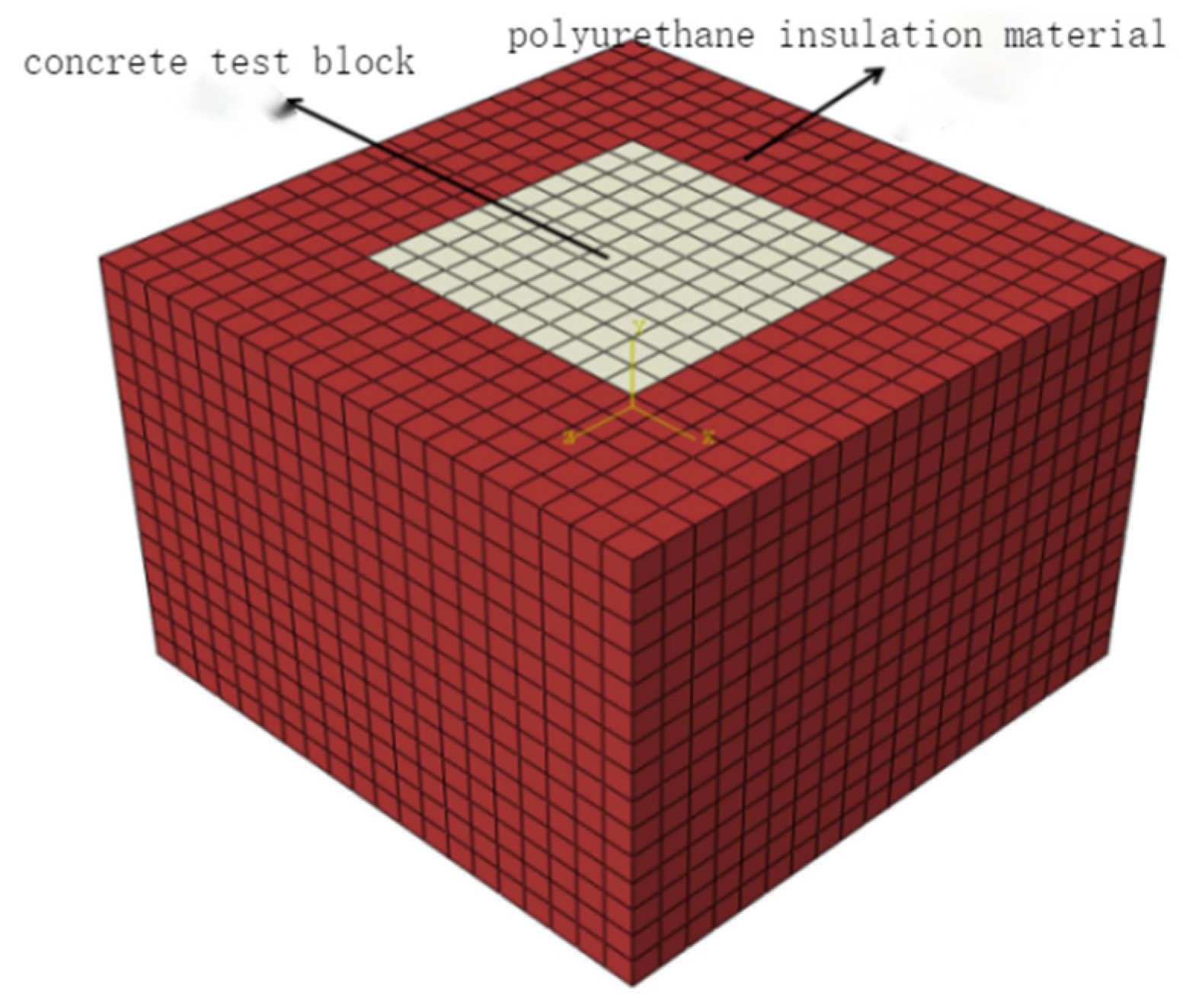




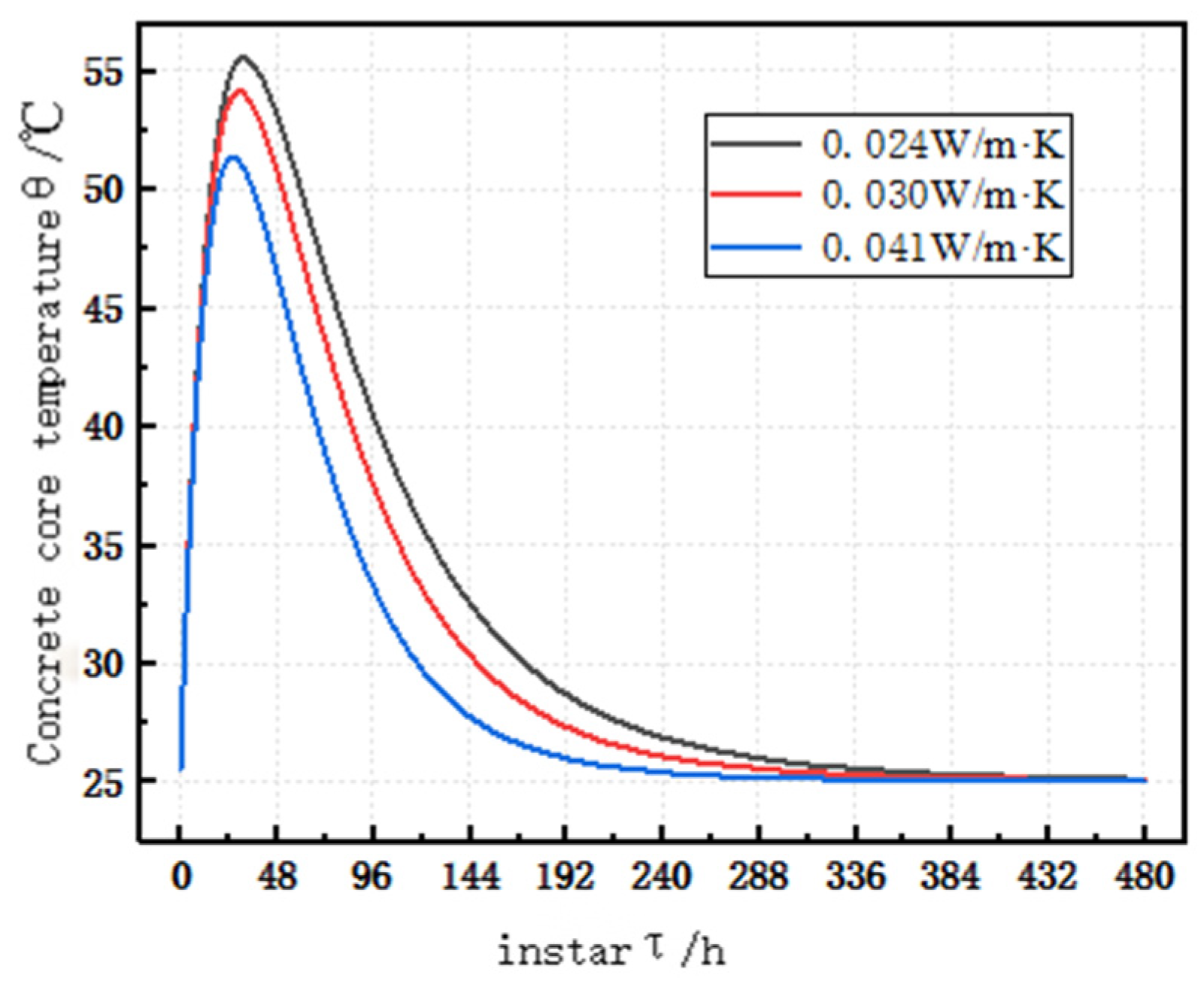
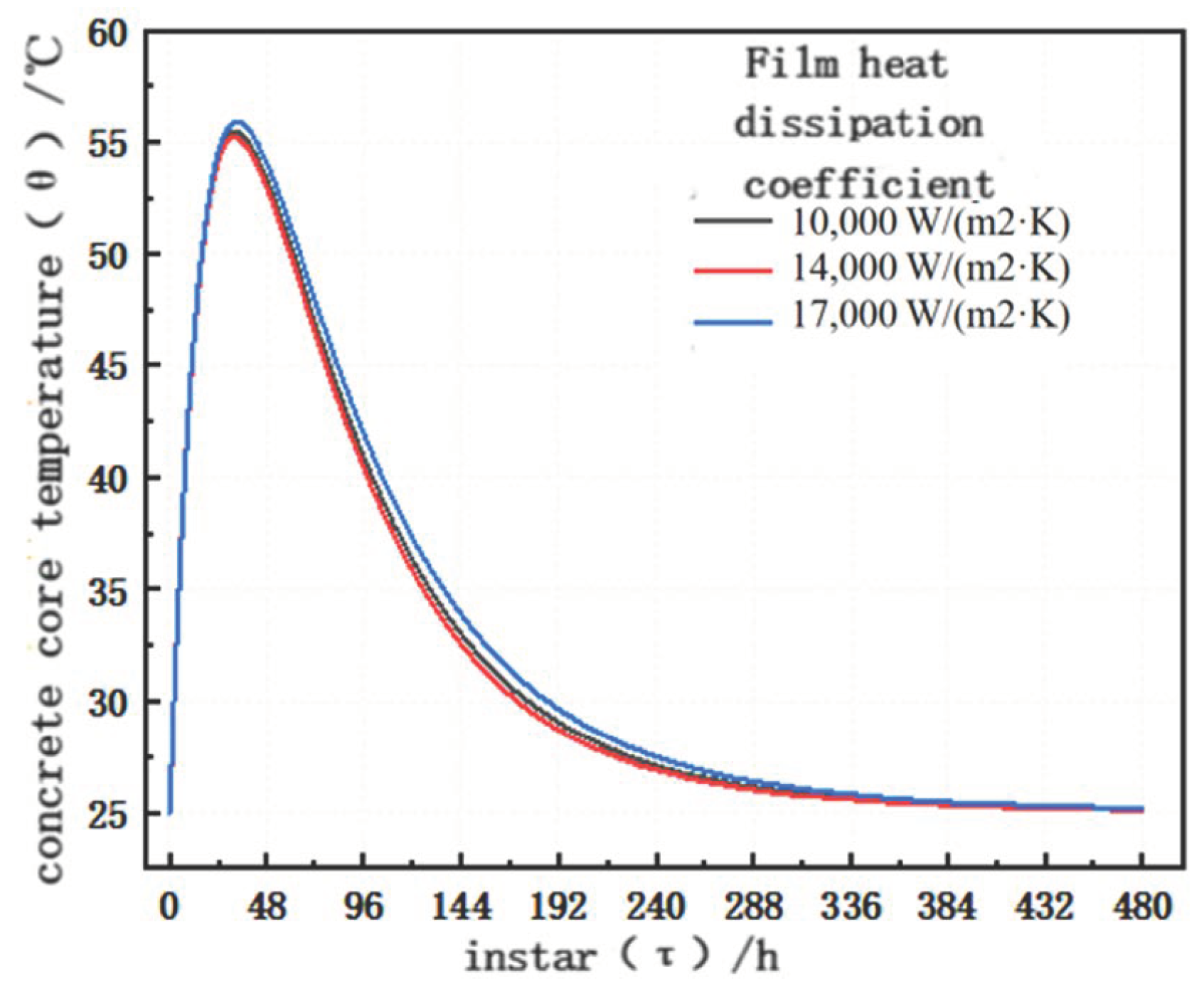


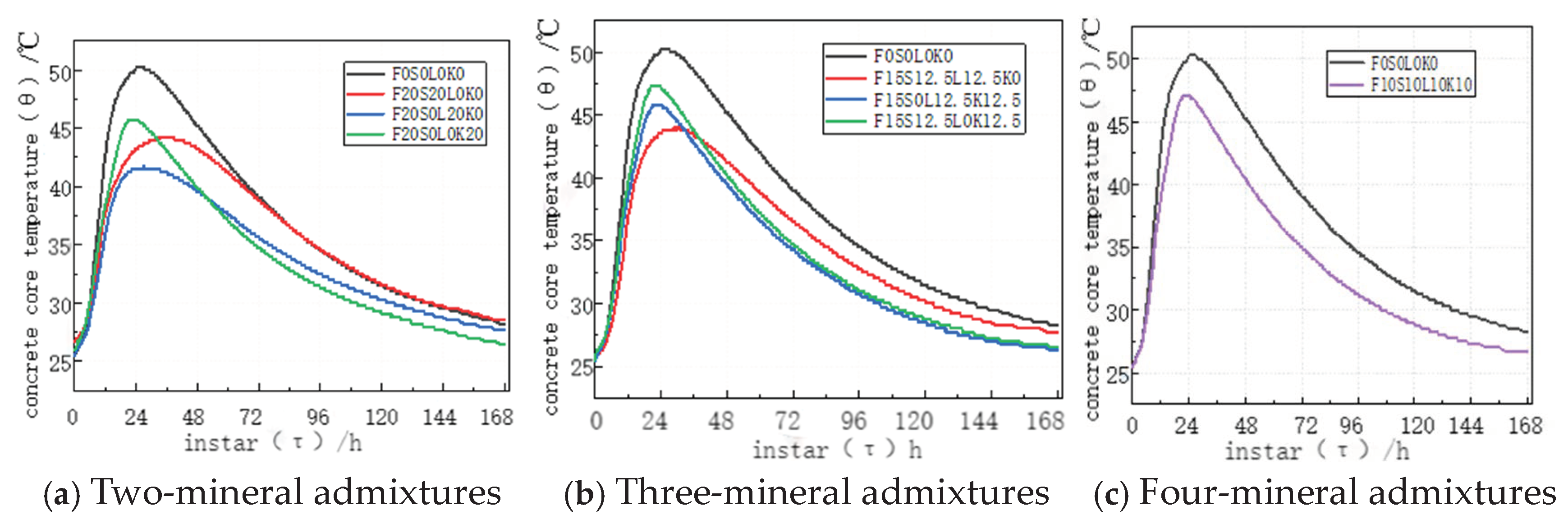
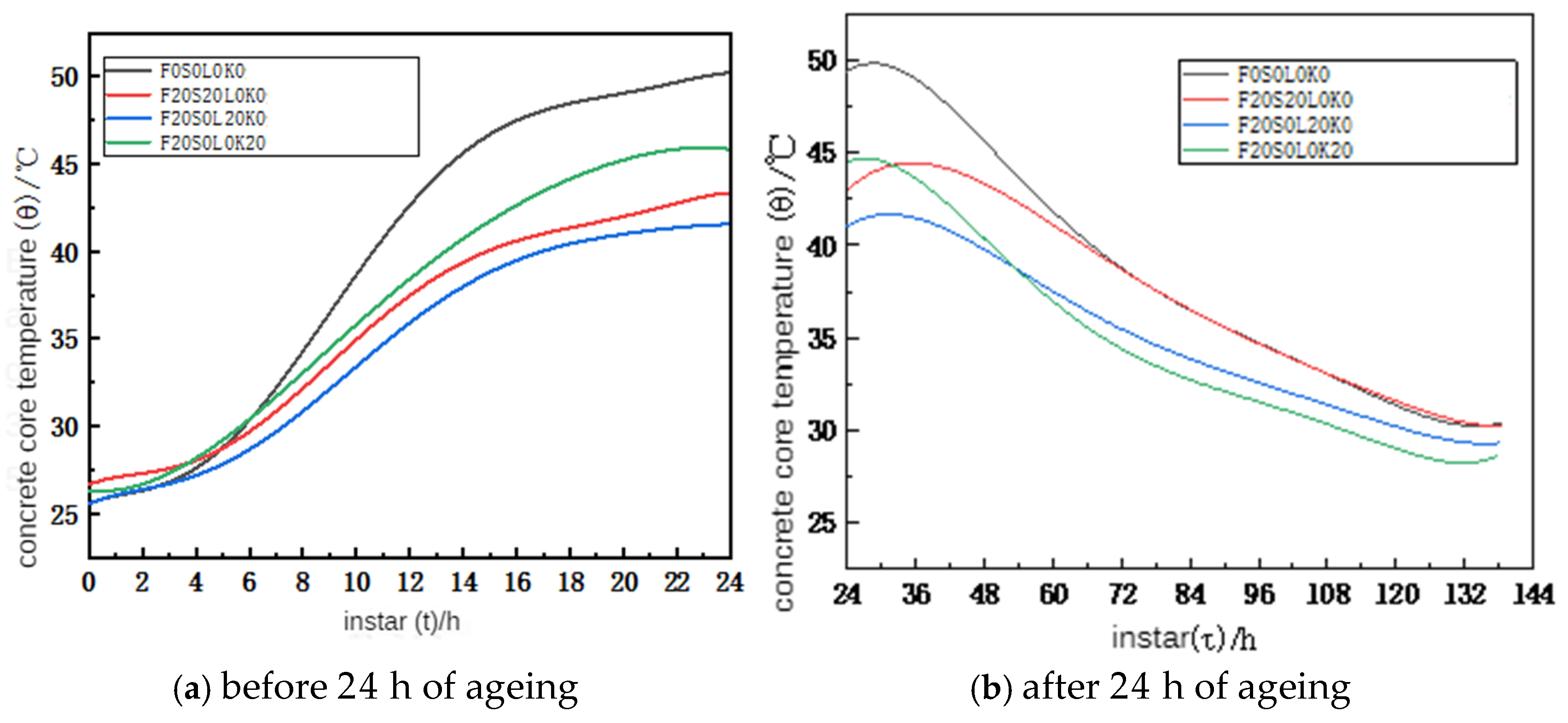



| Argument | Value |
|---|---|
| Thermal conductivity of concrete | 1.78 |
| Coefficient of thermal expansion of concrete | 1.0 × 10−5 |
| Specific heat of concrete (J/(kg·°C)) | 960 |
| Concrete mass density (kg/m2) | 2400 |
| Heat release model parameter Q0 (kJ/kg) | 3500 |
| Influence coefficient of hydration heat release model a | 0.36 |
| Influence coefficient of hydration heat release model b | 0.74 |
| Thermal conductivity of thermal insulation material (W/m·K) | 0.024 |
| Specific heat of insulation material (J/(kg·°C)) | 1200 |
| Insulation material density (kg/m2) | 36 |
| Film heat dissipation coefficient | 17,000 |
| Emissivity | 0.77 |
| Absolute zero degree Celsius (°C) | −273.15 |
| Stefan–Boltzmann constant | 5.669 × 10−14 |
| Mold entry temperature (°C) | 25.5 |
| ID | Cement(kg) | Fly ash (kg) | Slag (kg) | Limestone powder (kg) | Metakaolin (kg) | Sand (kg) | ||
| F0S0L0K0 | 420.0 | 0.0 | 0.0 | 0.0 | 0.0 | 745.0 | ||
| F20S20L0K0 | 252.0 | 84.1 | 84.1 | 0.0 | 0.0 | 745.0 | ||
| F20S0L20K0 | 252.0 | 84.1 | 0.0 | 84.1 | 0.0 | 745.0 | ||
| F20S0L0K20 | 252.0 | 84.1 | 0.0 | 0.0 | 84.1 | 745.0 | ||
| F15S12.5L12.5K0 | 252.0 | 63.0 | 52.5 | 52.5 | 0.0 | 745.0 | ||
| F15S12.5L0K12.5 | 252.0 | 63.0 | 52.5 | 0.0 | 52.5 | 745.0 | ||
| F15S0L12.5K12.5 | 252.0 | 63.0 | 0.0 | 52.5 | 52.5 | 745.0 | ||
| F10S10L10K10 | 252.0 | 42.0 | 42.0 | 42.0 | 42.0 | 745.0 | ||
| ID | Stone (kg) | Water (kg) | Admixture (kg) | Volume (m3) | ||||
| F0S0L0K0 | 1117.0 | 168.0 | 2.5 | 0.008 | ||||
| F20S20L0K0 | 1117.0 | 168.0 | 2.5 | 0.008 | ||||
| F20S0L20K0 | 1117.0 | 168.0 | 2.5 | 0.008 | ||||
| F20S0L0K20 | 1117.0 | 168.0 | 2.5 | 0.008 | ||||
| F15S12.5L12.5K0 | 1117.0 | 168.0 | 2.5 | 0.008 | ||||
| F15S12.5L0K12.5 | 1117.0 | 168.0 | 2.5 | 0.008 | ||||
| F15S0L12.5K12.5 | 1117.0 | 168.0 | 2.5 | 0.008 | ||||
| F10S10L10K10 | 1117.0 | 168.0 | 2.5 | 0.008 | ||||
| Specimen Number | Maximum Temperature (°C) | Age at Which the Maximum Temperature Is Reached (h) | Temperature at Age 5 d (°C) | Maximum Temperature Rise Rate (°C/h) |
|---|---|---|---|---|
| F0S0L0K0 | 50.25 | 24.00 | 31.50 | 2.25 |
| F20S20L0K0 | 44.25 | 38.00 | 31.25 | 1.35 |
| F20S0L20K0 | 41.75 | 27.00 | 30.25 | 1.25 |
| F20S0L0K20 | 45.75 | 22.00 | 29.00 | 1.36 |
| F15S12.5L12.5K0F | 43.00 | 30.00 | 30.00 | 1.40 |
| 15S0L12.5K12.5F1 | 45.75 | 22.00 | 28.75 | 1.45 |
| 5S12.5L0K12.5F10 | 47.25 | 21.00 | 28.50 | 1.60 |
| S10L10K10 | 47.00 | 23.00 | 28.00 | 1.50 |
Disclaimer/Publisher’s Note: The statements, opinions and data contained in all publications are solely those of the individual author(s) and contributor(s) and not of MDPI and/or the editor(s). MDPI and/or the editor(s) disclaim responsibility for any injury to people or property resulting from any ideas, methods, instructions or products referred to in the content. |
© 2024 by the authors. Licensee MDPI, Basel, Switzerland. This article is an open access article distributed under the terms and conditions of the Creative Commons Attribution (CC BY) license (https://creativecommons.org/licenses/by/4.0/).
Share and Cite
Wu, K.; Liu, Z.; Wang, C.; Yang, T.; Dou, Z.; Xu, J. Study of Semi-Adiabatic Temperature Rise Test of Mineral Admixture Concrete. Buildings 2024, 14, 2941. https://doi.org/10.3390/buildings14092941
Wu K, Liu Z, Wang C, Yang T, Dou Z, Xu J. Study of Semi-Adiabatic Temperature Rise Test of Mineral Admixture Concrete. Buildings. 2024; 14(9):2941. https://doi.org/10.3390/buildings14092941
Chicago/Turabian StyleWu, Ke, Zhenhua Liu, Cao Wang, Tao Yang, Zhongyu Dou, and Jiaxiang Xu. 2024. "Study of Semi-Adiabatic Temperature Rise Test of Mineral Admixture Concrete" Buildings 14, no. 9: 2941. https://doi.org/10.3390/buildings14092941






